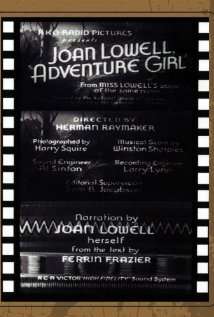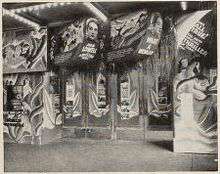Adventure Girl
| Adventure Girl | |
|---|---|
 Title card from film | |
| Directed by | Herman Raymaker |
| Produced by | Amadee J. Van Beuren[1] |
| Written by | Ferrin Frazier |
| Based on |
the novel, The Cradle of the Deep by Joan Lowell |
| Starring | Joan Lowell |
| Narrated by | Joan Lowell |
| Music by | Winston Sharples |
| Cinematography | Harry Squire |
| Edited by | Sam B. Jacobson |
Production company | |
| Distributed by | RKO Radio Pictures |
Release dates |
|
Running time | 76 minutes |
| Country | United States |
| Language | English |
Adventure Girl (1934) is an American adventure documentary directed by Herman Raymaker, based on dialogue written by Ferrin Frazier, starring and narrated by Joan Lowell. The screenplay is based on the autobiography of Lowell, The Cradle of the Deep, which later turned out to be a work of fiction.
Plot
Joan Lowell travels by sea with her father, Nicholas Wagner, as the captain, and two additional crew, William Sawyer and Otto Siegler. During their voyage, their ship is damaged in a hurricane, her mast broken. Coming upon the wrecks of other ships, they find a mast that they can use to replace their broken one. As the two crewmembers begin salvaging the map, Lowell and Wagner explore other wrecks, where Lowell comes upon an old map which supposedly leads to ruins in the jungle which contain a precious emerald.
After replacing the mast, they continue their journey, but need to find a water supply to replenish their drinking water, which was also lost during the hurricane. Lowell and Sawyer take a rowboat to the coast, where they meet a native who takes them to his village. Lowell realizes that this village is on the map she discovered, and convinces the local leader, Maya, to allow her and Sawyer to explore. When the party comes upon the lost city, Lowell begins to search for the emerald. When their guide, Manola, and Maya realize Lowell's intention, they take her prisoner with the intent to burn her alive. Sawyer rescues her from certain death, and the two escape back to their rowboat. As they are pursued by the native villagers in their canoes, Sawyer dumps gasoline into the waters behind them, and sets it on fire. This prevents the villagers from continuing their pursuit, and the two erstwhile treasure hunters return to their ship.
Cast
- Joan Lowell as Herself
- Captain Nicholas Wagner as Himself
- William Sawyer as Himself
- Otto Siegler as Himself
Production

The screenplay was based on Lowell's novel, Cradle of the Deep, which at the time of its publishing was advertised as an autobiography. It was chosen by the Book of the Month Club, and became a best-seller in 1929. However, shortly after becoming famous, the book was exposed as a work of fiction. Modern sources still cite this film as a documentary, however, at the time of its release, sources reviewed it as a work of fiction.[3][4] The film was shot on location in Guatemala.[5] In July of 1934, it was reported that production had completed, with filming done in Central America.[6] The film began previews in early August,[7] with one of these previews occurring aboard the S.S. Columbia on August 1, 1934.[8]
Shot in black and white, the climax of the film, the fire scene, was hand colored by Gustav Brock. [9]
The film opened on August 17, 1934, at the Rialto Theater in New York City. Several marketing schemes were put in place to coincide with the film's opening, including a newspaper essay contest with the winner receiving a free trip to Haiti, fashion tie-ins featuring Joan Lowell, and theater lobbies decorated in jungle motifs. [4]
Reception
Motion Picture Daily gave the film a good review as outdoor adventure, singling out the sea photography, and the colorization sequence by Brock.[10] The Brooklyn Daily Eagle gave the film a mostly negative review, mostly due to the amateur nature of the actors, but they did compliment the photography, calling it "excellent", but a wasted effort.[11] The Hollywood Reporter felt that it was a good family adventure film. The New York Daily News complimented Brock's coloring of the fire scene, and praised the cinematography in general. the New York Daily Mirror also praised the photography, while the New York World-Telegram called the film "as amusing and exciting an hour as you can imagine in the cinema."[12] The Film Daily called it an "Unusual adventure film with good exploitation values." They also Lowell's acting as well as the photography.[13]
References
- ↑ "What They're Down For: Producers". Motion Picture Daily. June 20, 1934. p. 10. Retrieved August 9, 2015.
- ↑ "Adventure Girl: Detail View". American Film Institute. Archived from the original on April 2, 2014. Retrieved September 8, 2014.
- ↑ Colby, Anne (March 14, 2008). "Meet the grandmother of memoir fabricators". Los Angeles Times. Retrieved August 9, 2015.
- 1 2 "Offer Free Tropics Trip on 'Adventure'". Motion Picture Herald. August 18, 1934. p. 63. Retrieved August 9, 2015.
- ↑ Alicoate, Charles (August 23, 1934). "Short Shots from Eastern Studios". The Film Daily. p. 8. Retrieved August 9, 2015.
- ↑ "Joan Lowell Feature Finished". The Film Daily. Retrieved August 9, 2015.
- ↑ ""Adventure Girl" for Rialto". The Film Daily. July 27, 1934. p. 2. Retrieved August 9, 2015.
- ↑ "Preview 'Adventure Girl'". Motion Picture Daily. August 2, 1934. p. 8. Retrieved August 9, 2015.
- ↑ "Brock Colors "Adventure Girl"". The Film Daily. August 7, 1934. p. 2. Retrieved August 9, 2015.
- ↑ ""Adventure Girl"". Motion Picture Daily. August 3, 1934. p. 2. Retrieved August 9, 2015.
- ↑ "Obituary Notes: Charles Wingate". The Brooklyn Daily Eagle. August 9, 1934. p. 9. Retrieved August 9, 2015 – via Newspapers.com.

- ↑ "Joan Lowell "Adventure Girl"". Motion Picture Herald. September 15, 1934. p. 21. Retrieved August 9, 2015.
- ↑ "Reviews: Joan Lowell in "Adventure Girl"". The Film Daily. August 3, 1934. p. 8. Retrieved August 9, 2015.